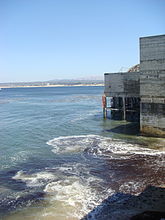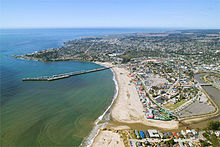
Monterey Bay


Monterey Bay is a bay of the Pacific Ocean located on the coast of the U.S. state of California, south of the San Francisco Bay Area. San Francisco itself is further north along the coast, by about 75 miles (120 km), accessible via CA 1 and US 101.

Santa Cruz is located at the north end of the bay, and Monterey is on the Monterey Peninsula at the south end. The "Monterey Bay Area" is a regional term used to describe the Monterey Bay-adjacent Central Coast communities of Santa Cruz, Monterey, and San Benito counties. The three counties, along with Monterey Bay-adjacent cities, collaborate in the Association of Monterey Bay Governments (AMBAG) on regional issues and come together for events like the State of the Region hosted by the Monterey Bay Economic Partnership.

Toponymy

The first European to enter Monterey Bay was Juan Rodríguez Cabrillo on November 16, 1542, while sailing northward along the coast on an imperial Spanish naval expedition. He named the bay Bahía de los Pinos,[1] probably because of the forest of pine trees first encountered while rounding the peninsula at the southern end of the bay.[2] Cabrillo's name for the bay was lost, but the westernmost point of the peninsula is still known as Point Pinos.

On December 10, 1595, Sebastián Rodríguez Cermeño crossed the bay and bestowed the name Bahía de San Pedro in honor of Saint Peter Martyr.[2][3]

The present name for the bay was given in 1602 by Sebastián Vizcaíno, who had been tasked by the Spanish government to complete a detailed chart of the coast. On December 16, 1602 he rounded a large peninsula and entered a bay that he named Puerto de Monterrey in honor of Don Gaspár de Zúñiga y Acevedo, 5th Count of Monterrey, who was the governor of New Spain and had dispatched the expedition.[1][4] Monterrey is an alternate spelling of Monterrei, a municipality in the Galicia region of Spain from which the viceroy and his father (the Fourth Count of Monterrei) originated.



All other place names in the vicinity containing Monterey were so named because of their proximity to the bay. This includes the Presidio of Monterey, City of Monterey, County of Monterey and Monterey Canyon.

Geology
The Monterey Canyon, one of the largest underwater canyons in the world, begins off the coast of Moss Landing, in the center of Monterey Bay. It is 249 miles (401 km) long, although its shape changes regularly because of currents and sediment being left in the area. The canyon is much like that of a continental slope; the biology of the canyon changes significantly in different parts of the canyon.[5]

Flora and fauna
Monterey Bay is home to many species of marine mammals, including sea otters, harbor seals, and bottlenose dolphins; as well as being on the migratory path of gray and humpback whales and a breeding site for elephant seals. Killer whales are atypically found along the coast,[6] especially when gray whales migrate, as they hunt the whales during their migration north. Many species of fish, sharks, mollusks such as abalone and squid, birds, and sea turtles also live in the bay. Several varieties of kelp grow in the bay, some becoming as tall as trees, forming what is known as a kelp forest.

Marine protected areas
Soquel Canyon State Marine Conservation Area, Portuguese Ledge State Marine Conservation Area, Pacific Grove Marine Gardens State Marine Conservation Area, Lovers Point State Marine Reserve, Edward F. Ricketts State Marine Conservation Area and Asilomar State Marine Reserve are marine protected areas in Monterey Bay. Like underwater parks, these marine protected areas help conserve ocean wildlife and marine ecosystems.

Communities around Monterey Bay

Clockwise around the bay, generally from north to south. Inland communities are indented:

- Santa Cruz
- Capitola
- Aptos
- Rio del Mar
- La Selva Beach
- Moss Landing
- Marina
- Seaside
- Sand City
- Monterey
- New Monterey
- Pacific Grove
- Carmel
- Carmel Highlands
In popular culture
Apple's desktop operating system, macOS Monterey, is named after this region.

Gallery
-
Monterey Bay seen with the old Cannery Foundations
-
One of many beaches along the Monterey Bay coastline
-
Monterey Bay as seen from Soquel, California. The Moss Landing power plant is visible in the distance.
-
Scuba diving lessons in the bay, near Monterey, California
-
Albert Bierstadt, Bay of Monterey, oil on paper, undated
-
Aerial view of the north end of Monterey Bay at Santa Cruz
See also
References
- ^ a b Gudde, Erwin G. (1949). California Place Names. Berkeley, Calif.: University of California Press. p. 222. ASIN B000FMOPP4.
- ^ a b Clark, Donald T. (1991). Monterey County Place Names. Carmel Valley, Calif.: Kestrel Press. p. 322. ISBN 978-1-880478-00-4.
- ^ Wagner, Henry R. (1937). Cartography of the Northwest Coast of America to the Year 1800. Berkeley, Calif.: University of California Press. p. 398. ASIN B001K5A42S.
- ^ "Dr. Hart's Mansion - Pacific Grove, California". hartmansion.com. Retrieved January 6, 2021.
- ^ "Monterey Canyon: Stunning deep-sea topography revealed | MBARI". www.mbari.org. February 22, 2016. Retrieved January 10, 2018.
- ^ Breen, Kerry (December 14, 2023). "'Rarely seen' killer whales spotted hunting sea lions off California coast". CBS News. CBS Interactive Inc. Retrieved August 25, 2024.
Orcas that are 'rarely seen' were caught on camera hunting sea lions off the California coast this week, the Monterey Bay Whale Watch said on Wednesday.
Further reading
- Palumbi, Stephen R.; Sotka, Carolyn (November 12, 2010). The Death and Life of Monterey Bay: A Story of Revival. Island Press. ISBN 978-1610911900.
External links
36°48′N 121°54′W / 36.800°N 121.900°W

- Monterey Bay
- Drainage basins of Monterey Bay
- Bays of California
- Bays of the Pacific Ocean
- Bodies of water of Monterey County, California
- Bodies of water of Santa Cruz County, California
- Regions of California
- Geography of Northern California
- Geography of Monterey County, California
- Geography of San Benito County, California
- Geography of Santa Cruz County, California
- Birdwatching sites in the United States
- Northern California
- Tourism regions of California
See what we do next...
OR
By submitting your email or phone number, you're giving mschf permission to send you email and/or recurring marketing texts. Data rates may apply. Text stop to cancel, help for help.
Success: You're subscribed now !








